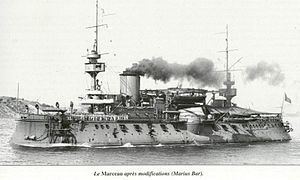Name Marceau Laid down 28 November 1882 Commissioned 18 April 1891 Launched 24 May 1887 Draft 8.3 m | Ordered October 1880 Completed 14 March 1891 Construction started 28 November 1882 Length 102 m Beam 20 m | |
 | ||
Namesake General François Séverin Marceau-Desgraviers | ||
Marceau was an ironclad turret ship built for the French Navy during the 1880s, the lead ship of her class. She served in the Mediterranean Squadron until 1900, when she was rebuilt and subsequently placed in reserve. She returned to service in 1906 as a torpedo training ship. During World War I, she served in Malta and Corfu as a submarine tender. The old ironclad was sold for scrapping in 1920, and while being towed to Toulon, she ran aground in a gale off Bizerte and became stranded. The wreck remained visible there until the 1930s.
Contents
Design
Marceau had an overall length of 101.6 meters (333 ft 4 in) and was 98.6 meters (323 ft 6 in) long between perpendiculars. She had a beam of 20.23 m (66 ft 4 in) and a draft up to 8.3 m (27 ft 3 in). She displaced 10,850 tonnes (10,680 long tons). The ship was powered by a pair of vertical triple-expansion steam engines, each driving one shaft, using steam provided by eight coal-fired cylindrical boilers that were trunked into a single large funnel. The engines were designed to reach 12,000 metric horsepower (8,800 kW) and propel the ship at a top speed of 16.5 knots (30.6 km/h; 19.0 mph), but they only managed 11,169 metric horsepower (8,215 kW) and 16.194 knots (29.991 km/h; 18.636 mph) on the ship's sea trials. Marceau had a range of 4,000 nautical miles (7,400 km; 4,600 mi) at a speed of 10 knots (19 km/h; 12 mph). She had a crew of 643–651 officers and enlisted men.
The ship was armed with a main battery of two 340-millimeter (13.4 in) M1881 28-caliber guns and two slightly newer M1884 guns of the same caliber. These weapons were mounted in individual barbettes in a "lozenge" arrangement, with one gun forward, one aft, and two amidships. The secondary battery consisted of sixteen 138.6 mm (5.46 in) M1884 quick-firing (QF) guns, all firing through unarmored embrasures in the hull. Marceau's light armament varies widely between sources: Chesneau & Kolesnik give a range of three to six 65 mm (2.6 in) 9-pounder guns, nine to eighteen 47 mm (1.9 in) 3-pounder guns, eight to twelve 37 mm (1.5 in) 1-pounder five-barrel Hotchkiss revolving cannon, and three to five 450 mm (18 in) torpedo tubes in deck-mounted launchers; naval historian Eric Gille gives four to seven 65 mm guns, nine to twelve 47 mm guns, eight 37 mm guns and five to six torpedo tubes, all above water; naval historian Paul Silverstone says six 65 mm guns, twelve 47 mm guns and five torpedo tubes. The ship's compound armor belt was 450 mm (17.7 in) thick amidships and reduced to 300 mm (11.8 in) at the stern and 230 mm (9.1 in). The barbettes were also 450 mm thick. The conning tower was protected by 120 mm (4.7 in) of armor plating and the deck was 80 mm (3.1 in) thick.
Service history
Marceau was ordered in October 1880, but was not laid down until 27 January 1882 at the Société Nouvelle des Forges et Chantiers de la Méditerranée shipyard in La Seyne-sur-Mer. Work proceeded slowly, and she was not launched until April 1890. This was a result of the influence of Admiral Théophile Aube, who was the Minister of Marine in 1886–87; Aube was a staunch advocate of the so-called Jeune École and opposed new battleship construction. Fitting out work was completed much more quickly, however, and she was commissioned into the French fleet on 14 March 1891. After her commissioning, she joined a French fleet that visited Kronstadt and was inspected by Czar Alexander III of Russia. On the return voyage, the fleet stopped in Spithead, where Queen Victoria reviewed the ships. This turned out to be the only time Marceau operated in the Atlantic; after returning to France, she was assigned to the Mediterranean Squadron, where she remained for the duration of her career.
In 1895, Marceau and the ironclads Courbet, Amiral Baudin, and Formidable all nearly ran aground off Hyères; Marceau and three tugs used to tow Amiral Baudin back to port. During the 1897 fleet gunnery trials, which saw the first use of a new system of centralized fire control in the French fleet, Marceau, her sister Neptune, and the new battleship Brennus all achieved more than 25 percent hits at ranges of between 3,000 yd (2,700 m) and 4,000 yd (3,700 m). On 30 August 1900, Marceau returned to La Seyne for a major reconstruction. Her heavy military masts were cut down, her engines were modernized and her boilers were replaced with 16 Niclausse boilers. Another 138.6 mm gun was installed in the bow under the forecastle. The work was completed in May 1902, and Marceau underwent a series of sea trials for the remainder of the year. She did not return to active service with the fleet, however, and was placed in reserve at Toulon. In 1906, she was converted into a training ship for torpedo operators in Toulon.
After the outbreak of World War I in August 1914, Marceau was converted into a floating workshop to support torpedo boats and submarines. She was initially based in Malta, but was later moved to Corfu and then to Bizerte in 1918. She was stricken from the naval register on 1 October 1920, and sold to a shipbreaking firm based in Toulon in 1921. While she was being towed to Toulon, a storm caused her to run aground off Bizerte. She remained visible there until the 1930s.
